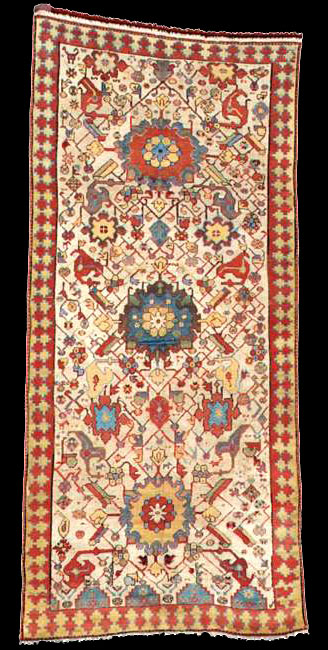 |
Azerbaijan rug with Afshan design in an ivory ground,
early 19th century
Museum description
AN AZERBAIJAN LONG RUG, SOUTH CAUCASUS,
LOT 90,
8,000—12,000 USD, approximately 10ft. 6in. by 4ft. 10in. (3.20 by 1.47m.),
mid-19th century oxidized
charcoals, repiling, reselvaged, rewoven end guard stripes, small reweaves
along edges
Sotheby's
Sale: N07852
| Location: New
York
Auction Dates: Session
1: Tue, 03 Dec 02 10:15 AM
The development of the harshang design,
from its formalized and multi-planed origins in the large scale Caucasian
"Floral" carpets of the 18th century to the relatively naive and asymmetric
rendering of mid-19th village weavings such as this, demonstrates both the
timelessness and adaptability of the design. Here the drawing is exuberant
and vivacious, the subtlety of the underlying grid system of vinery in the
18th century prototype is much more apparent, the delicate curvilinear
quality of the palmettes and split leaves are interpreted in an angular and
dramatic fashion with the focus firmly established on a central column of
three bold rosettes. The relationship between border and field has become
more integral with the border now acting as a dynamic motif rather than a
mere framing device. For an 18th century "Floral" carpet with the harshang design
and a reciprocal border see: Yetkin, Serare, Early
Caucasian Carpets in Turkey, Vol.
I, London, 1978, pl. 85. For related mid-19th century long rugs see:
Sotheby's New York, June 9, 1990, lot 48, Grogan, Boston, June 7, 1990, lot
123 and Bensoussan, Pamela, "Four "Harshang" Pattern Carpets in the Musée
des Arts Décoratifs", Hali, Vol.
3, No. 3, p. 209, No. 3 |

